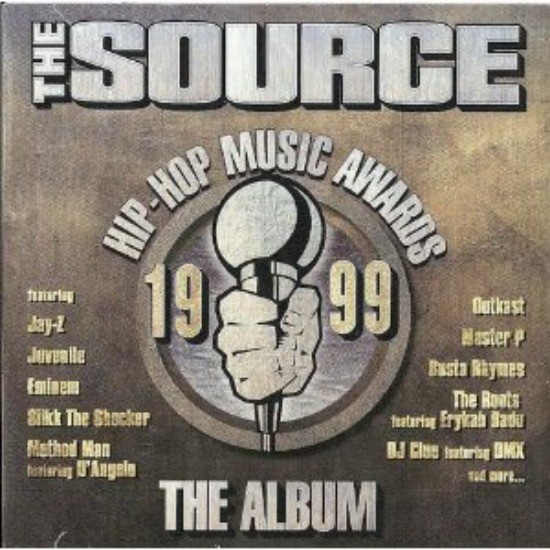
This month marks 15 years since The 1999 Source Awards were broadcast nationwide on UPN. While at first glance it may seem inconsequential to note the anniversary of yet another award show, these particular Source Awards were a landmark event for many reasons. Recorded at Los Angeles' Pantages Theater, the show marked the first time two major network television hours were devoted exclusively to hip-hop. From paying tribute to the pioneers to offering an accurate snapshot of the entire hip-hop nation, it's a surprisingly well done broadcast.
After revisiting a copy of the original broadcast (complete with commercials), here's 5 Things We Learned from the 1999 Source Awards.
]
Hip-Hop Made the Awards Their Own
While the night begins with a somewhat awkward start as most rappers and athletes aren't used to being around an award show podium and reading banter to each other off of cue-cards, a celebratory unifying vibe eventually fell into place. Hosted by Lisa “Left Eye” Lopes (fresh off of hosting duties on MTV's “The Cut”) and Naughty by Nature's Treach (who, at the time, was seemingly in every fifth movie that was released,) their presence bridged the gap between hip-hop and the award show format. While historically this was the third Source Awards ceremony, the television element came with its own set of restrictions, but Treach and Lopes helped that transition along smoothly.
Hip-Hop's Past, Present and Future Were in One Room
Watching the awards now, its attendance were a pretty staggering mix of hip-hop who's who both at the time, as well as the leaders of the next millennium. Of course there's the headliners of the time like Puff Daddy, Master P, and DMX (who weirdly no-showed his first award but was somehow in attendance to accept a later award as well as perform) but we also get the national television debuts of the very young Eminem and Lil Wayne.
Hip-Hop Was Commercially Commercial
The copy we obtained wasn't from the eventual commercial VHS release of the event, but the original UPN broadcast, so rap marketing was in full force. While there existed a pretty strong mainstream vs. underground divide at the time, the commercials showed how blurred those lines were. From a pre-love ballad Ja Rule performing a, well, love ballad in a Coca-Cola commercial to underground hero Pharoahe Monch re-writing the lyrics to his indie smash “Simon Says” to be about Lugz boots, to the top female MCs of yesteryear and '99 performing with Kool Keith of all people in a series of Sprite commercials, it's unclear which side hip-hop purists would have tried to be on.
[
Hip-Hop History Was (Pretty) Known and Well Shown
Outside the weird constant referring to hip-hop founder DJ Kool Herc as “Kool DJ Herc,” The Source Awards used the two-hour network platform to pay respect to many of the pioneers who paved the way. Afrika Bambaataa, Grandmaster Flash and DJ Kool Herc all received special recognition for their contributions, and while Bambaataa couldn't make the event, both Flash and Herc gave uninterrupted touching acceptance speeches encouraging the hip-hop youth of today. Later in the broadcast, Will Smith gave a lifetime achievement award to Russel Simmons, who Smith referred to as “the guy who looks just like Run, except really old.” Many of the acceptance speeches also acknowledged the greats, including Busta Rhymes who shouted out the Cold Crush Brothers, Run-DMC, The Fat Boys and Kurtis Blow.
Sometimes Excess Was A Little Too Much
With the music industry was hitting a zenith, The Source Awards were able to spare no expense for its performers and their elaborate stage set-ups. Snoop Dogg had a giant Dog House, the Cash Money Millionaires had a helicopter, and Puffy had, well, pretty much everything. While giant flames, two giant logos, synchronized back-up dancers, a conveyor belt straight outta Jamiriquai, and giant stairs are all the makings for a sheer spectacle, something just feels off about Puff performing his “P.E. 2000” at the center of it all. Further damning it was when all the pomp and circumstance vanished once Nas came out to join Puff for “Hate Me Now.” While Nas, especially at this time, had something of a poor reputation for his live performances, something about just Puff and Nas rapping on the stage completely clicks and it becomes one of the night's absolute highlights. You can buy a lot of things, especially with 1999 music industry money, but moments like “Hate Me Now” are priceless.
See also:
The Top 10 Rappers in OC
10 More of OC's Best Rappers
Top Five Female Emcees in OC
Follow us on Twitter at @OCWeeklyMusic and like us on Facebook at Heard Mentality.

